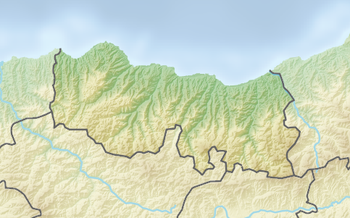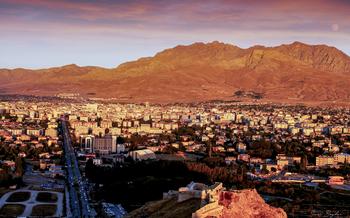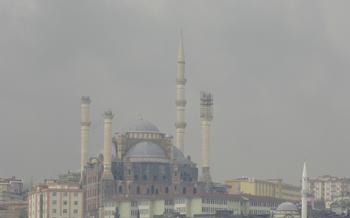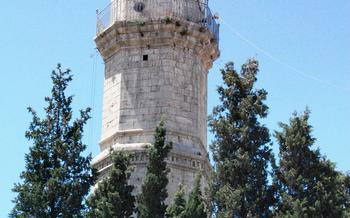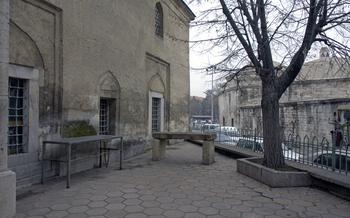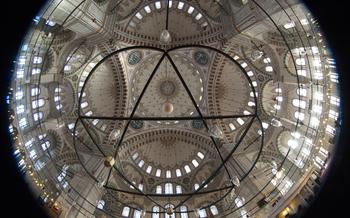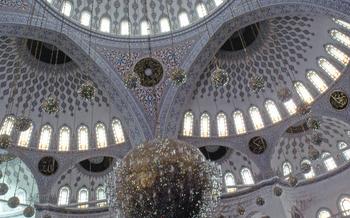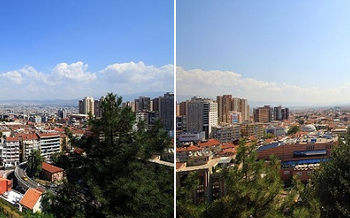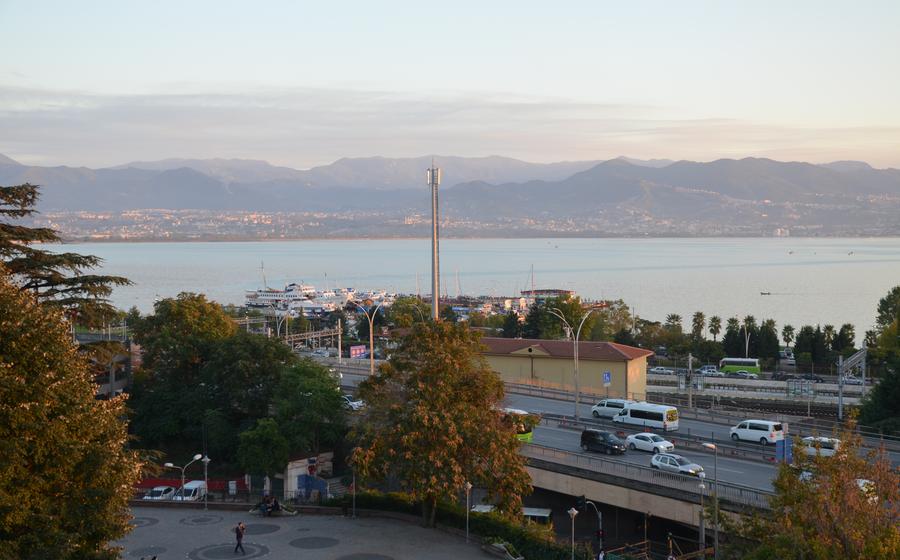
Cedit Neighborhood and Historical Ottoman Houses
- History of the Cedit Neighborhood:
- Exploration of Historical Ottoman Houses
- Cedit Mosque: A Beacon of Architectural Splendor and Religious Significance
- Çukurbağ Hamamı (Bathhouse)
- Cedit Bazaar (Çarşı): A Hub of Local Charm and Vibrant Trade
- Local Cuisine and Restaurants
- Coffeehouses and Tea Gardens: Indulge in Turkish Hospitality
- Traditional Crafts and Artisans
- Cultural Events and Festivals
- Shopping for Souvenirs and Handicrafts
- Accommodation Options
- Transportation and Accessibility
- Insider Tips for a Unique Neighborhood Experience
History of the Cedit Neighborhood:
The Cedit Neighborhood, nestled in the heart of İzmit, is a testament to the city's rich historical tapestry. Its origins can be traced back to the Ottoman Empire, when the area served as a hub for trade and commerce. The neighborhood's strategic location at the crossroads of major trade routes contributed to its rapid growth and development. Over the centuries, it attracted merchants, artisans, and traders from diverse backgrounds, shaping its unique architectural landscape and vibrant cultural identity. The Cedit Neighborhood's Ottoman heritage is evident in its well-preserved historical buildings, narrow cobblestone streets, and bustling markets, offering visitors a glimpse into the city's glorious past.
Exploration of Historical Ottoman Houses
The Cedit Neighborhood is home to a collection of beautifully preserved historical Ottoman houses, offering a glimpse into the lifestyle and culture of the empire's former residents. These houses, dating back to the 18th and 19th centuries, showcase unique architectural features and intricate craftsmanship.
Distinctive Characteristics:
-
Bay Windows: Many Ottoman houses in the neighborhood feature bay windows, known as "cumbalı," which extend over the street, providing panoramic views and allowing for better air circulation.
-
Wooden Elements: Wood plays a significant role in the construction and ornamentation of these houses. Elaborately carved wooden ceilings, cornices, and decorative panels add warmth and elegance to the interiors.
-
Courtyards and Gardens: Ottoman houses often have interior courtyards or gardens, providing a private oasis within the bustling city. These spaces were used for relaxation, family gatherings, and entertaining guests.
Insights into Ottoman Lifestyle:
-
Family Life: Ottoman houses were designed to accommodate extended families, with separate living quarters for different generations and private spaces for women.
-
Hospitality: Traditional Turkish hospitality is evident in the design of these houses, with large reception rooms and guest chambers to welcome visitors and entertain guests.
-
Craftsmanship: The intricate details and craftsmanship found in these houses reflect the high level of skill and artistry that existed during the Ottoman era.
Open for Visitors:
-
Kocaeli Museum: Located in a restored Ottoman house, the Kocaeli Museum showcases artifacts and exhibits related to the region's history and culture, providing a deeper understanding of the Ottoman era.
-
Hacı Ahmet Ağa Konağı: This well-preserved Ottoman mansion is now a boutique hotel, allowing visitors to experience the grandeur of Ottoman architecture while enjoying modern amenities.
-
Historical Houses on Cedit Street: Several historical houses along Cedit Street have been restored and converted into shops, cafes, or art galleries, offering visitors a chance to admire their architecture while exploring the neighborhood's vibrant atmosphere.
Cedit Mosque: A Beacon of Architectural Splendor and Religious Significance
Standing tall amidst the historical tapestry of the Cedit Neighborhood, the Cedit Mosque captivates visitors with its grandeur and architectural finesse. Built in the 16th century during the reign of Sultan Süleyman the Magnificent, the mosque holds immense historical significance as a testament to Ottoman architectural prowess. Constructed from cut stone, the mosque's exterior facade boasts intricate carvings and decorative elements that reflect the artistic sensibilities of the era.
The mosque's prayer hall is a haven of serenity, featuring a spacious layout adorned with elegant columns and arches. Its high ceiling is adorned with intricate patterns and calligraphy, creating a mesmerizing visual spectacle. The mihrab, a sacred niche indicating the direction of Mecca, is adorned with colorful tiles and intricate carvings, adding to the mosque's spiritual ambiance.
Beyond its architectural splendor, the Cedit Mosque serves as a vital hub for the neighborhood's religious and cultural identity. The mosque's five daily prayers are a call to unity, bringing the community together to worship and seek spiritual guidance. During the holy month of Ramadan, the mosque transforms into a center of communal gatherings, with special prayers, Quran recitations, and charitable activities taking place within its hallowed walls.
For visitors seeking a glimpse into the spiritual heart of the Cedit Neighborhood, the Cedit Mosque stands as a magnificent symbol of faith, history, and architectural brilliance. Open to visitors during non-prayer hours, the mosque offers a serene sanctuary to reflect, appreciate its architectural grandeur, and gain insights into the rich religious traditions of İzmit.
Çukurbağ Hamamı (Bathhouse)
In the heart of the Cedit Neighborhood lies Çukurbağ Hamamı, a historical was designed to provide a sanctuary for relaxation, cleansing, and social interaction.
Çukurbağ Hamamı boasts stunning architectural features that reflect the grandeur of the Ottoman era. Its intricate tilework, soaring domes, and elegant arched windows transport visitors back in time. Inside, the bathhouse comprises various chambers, including a dressing room, a hot room, a cold room, and a massage room, each serving specific functions in the traditional bathing ritual.
As visitors step into the bathhouse, they are greeted by a warm and humid atmosphere, reminiscent of the bygone era when bathing was an integral part of Turkish society. The hot room, with its marble floors and heated platforms, provides a soothing and therapeutic experience, allowing visitors to relax and rejuvenate their bodies.
Today, Çukurbağ Hamamı remains a functioning bathhouse, welcoming both locals and tourists who seek an authentic Turkish bathing experience. Visitors can indulge in a traditional massage, known as "kese," which involves a skilled attendant using a rough mitt to exfoliate and cleanse the skin. This refreshing ritual leaves visitors feeling revitalized and refreshed.
To experience Çukurbağ Hamamı fully, visitors are advised to follow the traditional bathing etiquette. These include removing shoes and wearing a pestemal, a traditional Turkish towel, while inside the bathhouse. Visitors should also be mindful of respecting the privacy of other bathers and maintaining a peaceful and serene atmosphere.
Cedit Bazaar (Çarşı): A Hub of Local Charm and Vibrant Trade
Strolling through the narrow, winding streets of the Cedit Neighborhood, visitors are greeted by the lively atmosphere and vibrant local culture of the Cedit Bazaar. This bustling marketplace is a hub of activity, where shopkeepers proudly display their wares and shoppers haggle for the best prices.
The air is filled with the sounds of vendors calling out their products, the clinking of tea glasses, and the laughter of locals going about their daily lives. The bazaar is a microcosm of İzmit, showcasing the city's rich cultural heritage and diverse offerings.
From traditional Turkish handicrafts and souvenirs to fresh produce, spices, and local delicacies, the Cedit Bazaar has something for everyone. Visitors can find intricately woven carpets, colorful ceramics, hand-painted lamps, and unique jewelry that reflect the region's artistic traditions.
For those seeking a culinary adventure, the bazaar offers an array of local specialties. From gözleme (stuffed flatbreads) and börek (filo pastry filled with cheese, spinach, or meat) to freshly squeezed pomegranate juice and sweet Turkish delight, the bazaar is a foodie's paradise.
Bargaining is an essential part of the bazaar experience. Vendors are open to negotiation, and visitors can often secure great deals if they are willing to haggle. It's important to approach bargaining with a friendly and respectful attitude, as it is considered a social interaction in Turkish culture.
Whether you're looking for a unique souvenir, a delicious snack, or simply a glimpse into the daily life of İzmit, the Cedit Bazaar is a must-visit destination. Immerse yourself in the vibrant atmosphere, engage with the friendly locals, and discover the treasures that this bustling marketplace has to offer.
Local Cuisine and Restaurants
İzmit's rich culinary heritage offers a delectable array of traditional dishes that reflect the region's diverse influences. In the heart of the Cedit Neighborhood, visitors can embark on a gastronomic journey that tantalizes their taste buds. Authentic Turkish restaurants line the charming streets, each offering a unique culinary experience.
One must-try dish is the legendary "İzmit Köfte," succulent meatballs simmered in a flavorful tomato sauce. The "Cevizli Sucuk" is a delectable local sausage made with ground beef, walnuts, and spices, offering a unique and unforgettable taste.
For seafood enthusiasts, the "Izgara Balık" is a must-have. Freshly caught fish from the nearby Sea of Marmara is grilled to perfection, preserving its delicate flavor and natural sweetness. Accompany your meal with a refreshing glass of "Şalgam Suyu," a tangy pickled turnip juice that perfectly complements the rich flavors of Turkish cuisine.
When dining in Turkish restaurants, embrace the local customs and etiquette. Show respect by greeting the staff and fellow diners with a warm "Merhaba" (Hello). Don't rush your meal; take your time to savor each dish and enjoy the convivial atmosphere.
Remember to try "çay" (Turkish tea), a ubiquitous beverage deeply ingrained in Turkish culture. Served in small tulip-shaped glasses, this aromatic tea is the perfect accompaniment to your culinary adventure in the Cedit Neighborhood.
Coffeehouses and Tea Gardens: Indulge in Turkish Hospitality
In the heart of the Cedit Neighborhood, coffeehouses and tea gardens stand as cherished meeting places, where locals and visitors alike congregate to savor the flavors of Turkish hospitality. These establishments are not merely places to consume beverages but spaces where conversations flow, stories are shared, and friendships are forged.
The aromatic allure of freshly brewed Turkish coffee fills the air, inviting passersby to step into these cozy havens. Skilled baristas, known as "kahvecis," meticulously prepare each cup, ensuring a rich, flavorful experience. Whether you prefer your coffee strong and bitter or sweet and milky, there's a variation to suit every taste.
Tea, a beverage deeply intertwined with Turkish culture, is also widely enjoyed in the neighborhood's tea gardens. Sip on a steaming glass of freshly brewed çay, savoring its delicate yet invigorating flavor. As you relax and soak in the inviting ambiance, you'll witness firsthand the social significance of these gatherings.
In Turkish culture, coffeehouses and tea gardens transcend their primary function as places to consume beverages. They serve as vibrant social hubs, where people from all walks of life come together to connect, exchange ideas, and engage in lively debates. Whether you're a local catching up with friends or a traveler seeking cultural immersion, these establishments offer a warm and welcoming environment for all.
So, as you explore the Cedit Neighborhood, be sure to step into one of its many coffeehouses or tea gardens. Indulge in the flavors, embrace the convivial atmosphere, and experience the true essence of Turkish hospitality.
Traditional Crafts and Artisans
The Cedit Neighborhood is renowned for its thriving community of traditional artisans who carry on centuries-old crafts and techniques. Visitors can immerse themselves in the neighborhood's rich artistic heritage by visiting workshops and studios where they can observe artisans at work and learn about their processes.
One of the most captivating crafts is carpet weaving, where skilled artisans use looms to create intricate and colorful carpets adorned with traditional motifs. Visitors can witness the transformation of raw wool into vibrant masterpieces, each one a testament to the artisan's skill and patience.
Copperware, another prominent craft in the neighborhood, showcases the artisans' mastery of metalworking. Visitors can watch as artisans skillfully hammer and shape copper into a variety of decorative objects, from ornate trays and pots to intricate lamps and jewelry.
Calligraphy, the art of beautiful handwriting, is also highly valued in the Cedit Neighborhood. Visitors can admire the intricate script and delicate brushwork of master calligraphers, who create personalized works of art and traditional Islamic calligraphy.
Exploring the neighborhood's traditional crafts offers a unique glimpse into the cultural heritage of İzmit and provides an opportunity to appreciate the skill and artistry of local artisans. Visitors can purchase handmade crafts as souvenirs or gifts, knowing that they are supporting the preservation of these traditional art forms.
Cultural Events and Festivals
The Cedit Neighborhood, with its rich history and vibrant community, plays host to an array of cultural events and festivals throughout the year. These events celebrate the neighborhood's unique heritage and offer visitors an immersive experience into Turkish traditions.
One of the most significant events is the annual Cedit Festival, held during the summer months. The festival showcases traditional Turkish music, dance, and art, with performances by local and national artists. Visitors can also indulge in delicious Turkish cuisine, shop for handmade crafts, and participate in interactive workshops.
Other notable events include the Ottoman Heritage Festival, which focuses on the neighborhood's rich Ottoman past, and the Cedit Bazaar Festival, which features a lively market with traditional Turkish handicrafts, souvenirs, and local delicacies.
Attending these cultural events and festivals is an excellent way to immerse oneself in the vibrant atmosphere of the Cedit Neighborhood and gain a deeper understanding of Turkish culture. Visitors are encouraged to participate actively, engage with locals, and embrace the spirit of celebration.
To make the most of these cultural experiences, it's advisable to plan your visit around the festival dates. Additionally, it's recommended to dress respectfully, as these events often involve religious or traditional ceremonies.
Shopping for Souvenirs and Handicrafts
The Cedit Neighborhood is a treasure trove for souvenir hunters and those seeking unique handmade crafts. From traditional Turkish carpets and ceramics to intricate jewelry and hand-painted pottery, the neighborhood's shops and boutiques offer a diverse selection of authentic and high-quality items.
When shopping for souvenirs, be sure to visit the many small shops tucked away in the narrow streets and alleys. Here you'll find a variety of unique and locally made items, such as handwoven textiles, copperware, and leather goods. Don't be afraid to bargain with the shopkeepers, as this is a common practice in Turkey.
For those looking for more upscale souvenirs, there are several art galleries and boutiques in the neighborhood that showcase the work of local artists and designers. Here you can find one-of-a-kind pieces, such as paintings, sculptures, and jewelry, that will serve as lasting reminders of your time in İzmit.
Whether you're looking for a unique gift for a loved one or a special memento for yourself, you're sure to find something special in the Cedit Neighborhood. Be sure to set aside some time to explore the shops and boutiques, and don't forget to haggle for the best prices.
Accommodation Options
The Cedit Neighborhood offers a range of accommodation options for visitors seeking a unique and immersive experience. For those wishing to fully embrace the historical charm of the area, there are several restored Ottoman houses and boutique hotels that have been converted into charming guesthouses. These accommodations provide a glimpse into the past, allowing guests to experience the ambiance and lifestyle of the neighborhood's former residents.
For those seeking modern conveniences while still being close to the historical center, there are several reputable hotels located within walking distance of the Cedit Neighborhood. These hotels offer a range of amenities, including comfortable rooms, modern facilities, and easy access to local attractions.
It's important to book accommodations in advance, especially during peak tourist season, to secure a place to stay and avoid disappointment. Online booking platforms and local travel agencies can assist with finding the best options that suit your budget and preferences.
Whether you choose to stay in a historical Ottoman house or a modern hotel, the Cedit Neighborhood offers a welcoming and comfortable base from which to explore its rich history and cultural heritage.
Transportation and Accessibility
Reaching the Cedit Neighborhood is a breeze with multiple transportation options available. Take advantage of the well-connected public transportation system and hop on a bus or minibus that conveniently drops you off right at the neighborhood's doorstep. If you prefer the flexibility of your own vehicle, private cars and taxis are readily accessible, and there are designated parking areas for visitors. For those with limited mobility, the neighborhood is wheelchair-accessible, ensuring a comfortable and inclusive experience for all. To avoid the hustle and bustle, plan your visit during the shoulder seasons (April-May or September-October) when the weather is still pleasant but the crowds are smaller. Immerse yourself in the neighborhood's charm without the added stress of navigating through throngs of tourists.
Insider Tips for a Unique Neighborhood Experience
As you stroll through the labyrinthine streets of the Cedit Neighborhood, keep an eye out for hidden gems that reveal its rich past. One such treasure is a quaint bookshop tucked away in a small alley. Step inside to browse a collection of rare and antique books, many of which tell the stories of İzmit's history and culture.
For a taste of local flavors, head to the unassuming yet beloved Köfteci Mustafa, a family-run restaurant serving mouthwatering köfte (meatballs) and other traditional Turkish dishes. The friendly atmosphere and delicious food will make you feel like part of the neighborhood family.
To delve deeper into the neighborhood's traditions, join one of the many workshops offered by local artisans. Learn the art of Turkish tile-making, calligraphy, or even traditional Turkish coffee brewing. These hands-on experiences will give you a unique insight into the skills and passions of the Cedit residents.
As the sun sets, take a leisurely walk along the neighborhood's waterfront, where you can enjoy stunning views of the sea and the distant hills. This tranquil spot is perfect for reflecting on the beauty and history of the Cedit Neighborhood.
Remember to embrace the local customs and traditions during your visit. Greet the shopkeepers and residents with a warm "Merhaba" (hello) and don't be afraid to ask questions about the neighborhood's history and culture. The people of Cedit are known for their hospitality and will be delighted to share their stories with you. So, dive into the vibrant tapestry of the Cedit Neighborhood, where every corner holds a hidden gem waiting to be discovered.

